
Wasps in the family Pompilidae are commonly called spider wasps, spider-hunting wasps, or pompilid wasps. The family is cosmopolitan, with some 5,000 species in six subfamilies. Nearly all species are solitary, and most capture and paralyze prey, though members of the subfamily Ceropalinae are kleptoparasites of other pompilids, or ectoparasitoids of living spiders.

Episyron quinquenotatus, the white-trimmed black wasp, is a North American species of pompilid spider hunting wasp.
Dipogon bifasciatus is a spider wasp from the family Pompilidae.
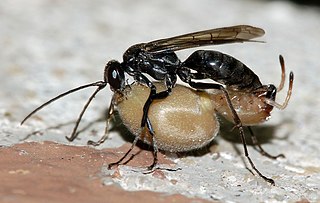
Auplopus carbonarius is a spider wasp of the family Pompilidae. Uniquely among the British group it constructs a nest of barrel-shaped cells in which spiders are stored and the larvae develop.
Cryptocheilus notatus is the largest species of spider wasps (Pompilidae) to be found in Great Britain reaching up to 18mm in length.
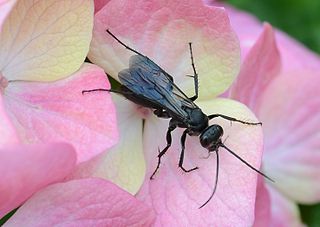
Anoplius nigerrimus is one of the most common spider wasps, or pompilids, in Europe. They are mostly black and the females are 6-8 mm long while males measure 5-8 mm. This species may be distinguished from the related Anoplius concinnus and Anoplius caviventris by the 20 setae, or hairs, on the forehead rather than 60 or 45.
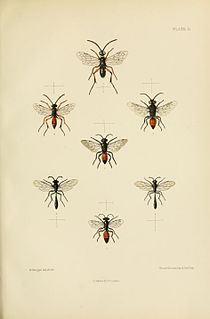
Ceropales maculata is a kleptoparasitic spider wasp found in the holoarctic region.

Aporus unicolor, common name cutpurse, is a highly specialised spider hunting wasp from the family Pompilidae.

Priocnemis monachus is a large spider wasp from New Zealand where it is known as the "black hunting wasp". It is the largest pompilid in New Zealand.
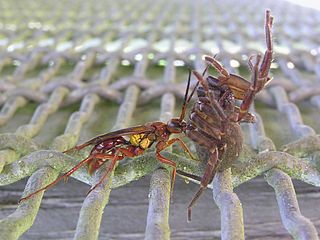
Sphictostethus nitidus, the golden hunter wasp or red spider wasp, is a species of pepsid spider wasp endemic to New Zealand.
Evagetes crassicornis is a kleptoparasitic spider wasp with a holarctic distribution.

Arachnospila trivialis is a widespread spider wasp of sandy soil areas of the Palaearctic.
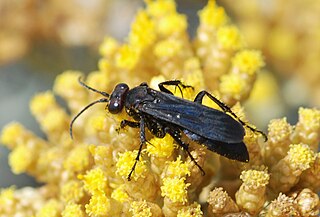
Agenioideus is a genus of spider wasps from the subfamily Pompilinae; the genus occurs in Europe, where 21 species are recorded, eastwards to Japan, in North America, South America, and Australia.

Caliadurgus fasciatellus is a species of spider wasp from the subfamily Pepsinae found from Western Europe to the Far East of Asia.

Auplopus albifrons is a spider wasp of the family Pompilidae.
Anoplius infuscatus is a species of spider wasp found mainly in Eurasia.

Anoplius americanus is a species of blue-black spider wasp which is widely distributed in the New World.

Tachypompilus analis, the red-tailed spider wasp is a species of spider wasp found in most of tropical and subtropical Asia, north to Japan. These spider wasps often hunt huntsman spiders.

Tachypompilus ferrugineus, the rusty spider wasp, red-tailed spider hunter, or sometimes red-tailed spider wasp is a species of spider wasp from the Americas. It preys mainly on wandering spiders, especially wolf spiders.

Poecilopompilus algidus is a species of spider wasp which is widespread in the Americas.
















